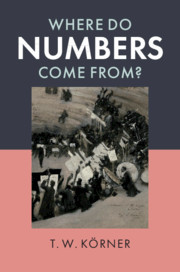Description
Where Do Numbers Come From?
Author: Körner T. W.
A clear, entertaining development of the number systems required in any course of modern mathematics.
Language: English
Subject for Where Do Numbers Come From?:
Where Do Numbers Come From?
Publication date: 10-2019
270 p. · 15.2x22.8 cm · Paperback
Publication date: 10-2019
270 p. · 15.2x22.8 cm · Paperback
Approximative price 86.50 €
In Print (Delivery period: 14 days).
Add to cart
Where Do Numbers Come From?
Publication date: 10-2019
270 p. · 15.7x23.5 cm · Hardback
Publication date: 10-2019
270 p. · 15.7x23.5 cm · Hardback
Description
/li>Contents
/li>Biography
/li>
Why do we need the real numbers? How should we construct them? These questions arose in the nineteenth century, along with the ideas and techniques needed to address them. Nowadays it is commonplace for apprentice mathematicians to hear 'we shall assume the standard properties of the real numbers' as part of their training. But exactly what are those properties? And why can we assume them? This book is clearly and entertainingly written for those students, with historical asides and exercises to foster understanding. Starting with the natural (counting) numbers and then looking at the rational numbers (fractions) and negative numbers, the author builds to a careful construction of the real numbers followed by the complex numbers, leaving the reader fully equipped with all the number systems required by modern mathematical analysis. Additional chapters on polynomials and quarternions provide further context for any reader wanting to delve deeper.
Introduction; Part I. The Rationals: 1. Counting sheep; 2. The strictly positive rationals; 3. The rational numbers; Part II. The Natural Numbers: 4. The golden key; 5. Modular arithmetic; 6. Axioms for the natural numbers; Part III. The Real Numbers (and the Complex Numbers): 7. What is the problem?; 8. And what is its solution?; 9. The complex numbers; 10. A plethora of polynomials; 11. Can we go further?; Appendix A. Products of many elements; Appendix B. nth complex roots; Appendix C. How do quaternions represent rotations?; Appendix D. Why are the quaternions so special?; References; Index.
T. W. Körner is Emeritus Professor of Fourier Analysis at the University of Cambridge. His previous books include The Pleasures of Counting (Cambridge, 1996) and Fourier Analysis (Cambridge, 1988).
© 2024 LAVOISIER S.A.S.

